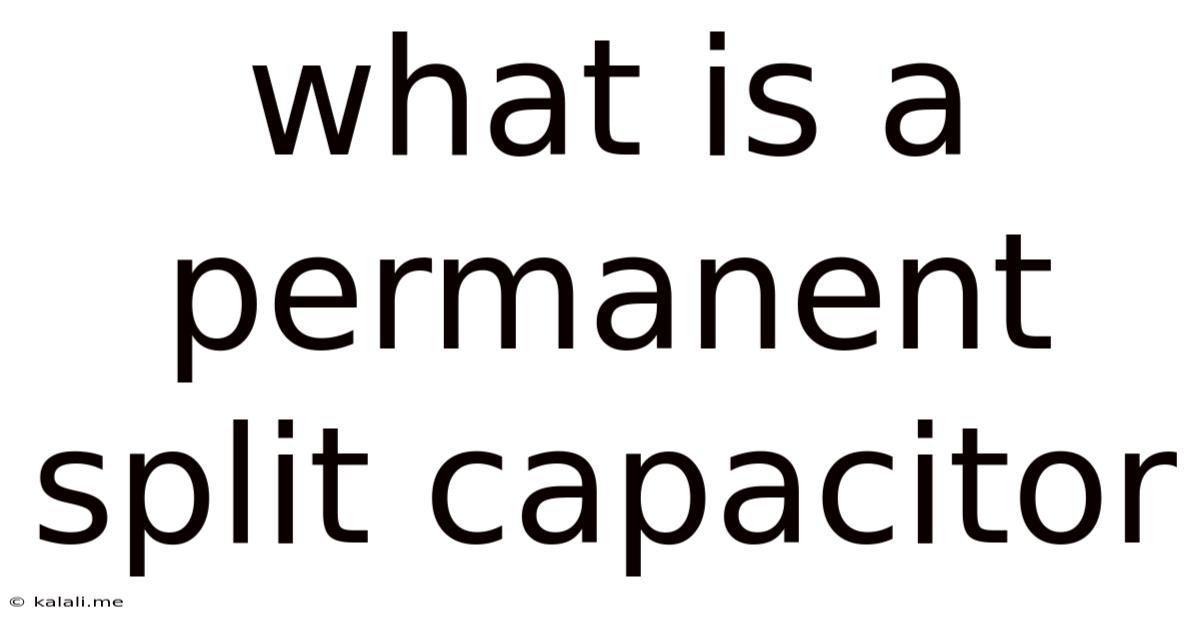What Is A Permanent Split Capacitor
Kalali
Jun 11, 2025 · 3 min read

Table of Contents
What is a Permanent Split Capacitor Motor? A Deep Dive into PSC Motors
A permanent split capacitor (PSC) motor is a type of single-phase induction motor, commonly found in everyday appliances like fans, blowers, and small pumps. Unlike other single-phase motors, the PSC motor uses a permanently connected capacitor in its circuitry, hence the name. This capacitor plays a crucial role in generating a rotating magnetic field, essential for starting and running the motor. This article will delve into the workings, applications, advantages, and disadvantages of PSC motors.
Understanding the Basics: How a PSC Motor Works
The heart of a PSC motor lies in its two windings: a main winding and an auxiliary winding. The main winding has a higher number of turns and a higher resistance compared to the auxiliary winding. A permanent capacitor is connected in series with the auxiliary winding. When power is supplied, current flows through both windings, but due to the capacitor, the current in the auxiliary winding leads the current in the main winding. This phase difference creates a rotating magnetic field, allowing the motor to start.
This rotating magnetic field interacts with the rotor (usually a squirrel cage type), inducing current and consequently torque. This torque starts the motor and continues to run it. The capacitor's presence ensures a relatively high starting torque compared to other single-phase motors, though lower than capacitor-start motors. It remains connected throughout the motor's operation, hence the term "permanent."
Key Components and their Functions:
- Main Winding: The primary winding responsible for the majority of the motor's torque.
- Auxiliary Winding: A smaller winding that aids in starting the motor.
- Permanent Capacitor: A capacitor connected in series with the auxiliary winding, creating the phase shift necessary for motor operation. This capacitor is usually a non-polarized electrolytic type or a metallized polypropylene film capacitor depending on the required motor performance.
- Rotor: Typically a squirrel-cage rotor, simple and robust in design.
Applications of PSC Motors:
Due to their relatively simple design, low cost, and acceptable starting torque, PSC motors find extensive applications in numerous household and industrial appliances:
- Fans: Ceiling fans, exhaust fans, and ventilation fans are common applications.
- Blowers: Used in heaters, dryers, and other similar applications requiring airflow.
- Small Pumps: Water pumps, coolant pumps, and other low-power pump applications.
- Household Appliances: Used in some kitchen appliances, like mixers and small food processors.
Advantages of PSC Motors:
- Simple and Robust Design: The design is relatively straightforward, making them cheaper to manufacture and maintain.
- Low Cost: Compared to other single-phase motor types, PSC motors offer a cost-effective solution.
- Acceptable Starting Torque: While not as high as capacitor-start motors, the starting torque is sufficient for many applications.
- Quiet Operation: Generally quieter than some other single-phase motor designs.
- Long lifespan: With proper use and maintenance, PSC motors provide reliable long term operation
Disadvantages of PSC Motors:
- Lower Starting Torque compared to Capacitor-Start Motors: While sufficient for many applications, starting torque is lower than that of capacitor-start induction motors.
- Lower Efficiency: Efficiency is generally lower compared to capacitor-run motors, especially under heavier load conditions.
- Limited Speed Control: Speed control options are more limited compared to other motor types. Speed variation is usually achieved through the use of variable voltage drives which can be more expensive.
- Sensitivity to Load: Performance can be negatively impacted by high-inertia loads.
Conclusion:
The permanent split capacitor motor presents a practical and economical solution for various applications requiring a simple, robust, and relatively low-cost single-phase induction motor. While they possess some limitations concerning starting torque and efficiency, their simplicity and suitability for many light to medium-duty applications make them a prevalent choice in various industries and households. Understanding their workings and characteristics is crucial for selecting the appropriate motor for a given task.
Latest Posts
Latest Posts
-
Somebody Once Told Me That The World Was Macaroni Lyrics
Jul 02, 2025
-
How Old Are You If Born In 1993
Jul 02, 2025
-
What Is 1 4 Of 1 4 Cup
Jul 02, 2025
-
Is Keri Russell Related To Kurt Russell
Jul 02, 2025
-
What Is Half Of 1 4 Teaspoon
Jul 02, 2025
Related Post
Thank you for visiting our website which covers about What Is A Permanent Split Capacitor . We hope the information provided has been useful to you. Feel free to contact us if you have any questions or need further assistance. See you next time and don't miss to bookmark.